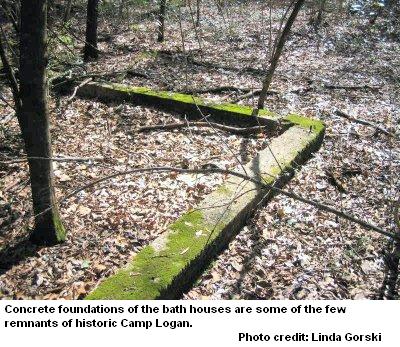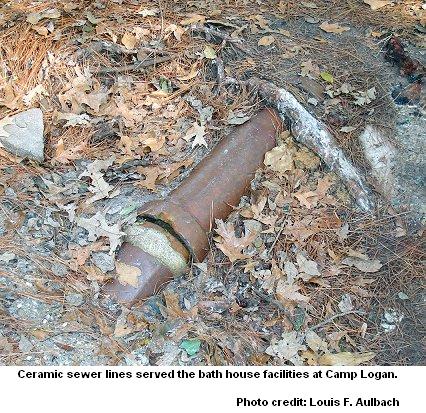According to a recent article in the
Memorial Park newsletter, major changes to running tracks, bicycle
trails and other recreational facilities are about to take place in
Memorial Park. How many of the folks who use Memorial Park realize that
lying right under their feet are the historic foundations of Camp
Logan, a World War I era Army base established in the Houston
area in 1917? Will any of these historic features will be destroyed by
upcoming improvements to the Park?
 Recently, we took to the woods behind the soccer fields at
the Park. After doing considerable research through documents, letters,
photographs and stories about Camp Logan we targeted a particular area
where we thought we might find foundation features of the barracks area
in which 35,000 soldiers lived while they were in military training
between 1917 and 1919, preparing to serve in the first World War.
We were guided to this particular area by a series of letters and
photos by a soldier named Corporal Paul B. Hendrickson who was
stationed at Camp Logan. An observant and intelligent soldier,
Hendrickson wrote long letters to his family and friends back in
Illinois. Miraculously, over 100 of these letters were uncovered
by his daughter following Mr. Hendrickson's death in 1990. These
letters also included a hand drawn map of the camp and sketches of life
at the training facility. The documents are an invaluable source of
information about Camp Logan, in particular, and also about WWI
training facilities, in general.
Recently, we took to the woods behind the soccer fields at
the Park. After doing considerable research through documents, letters,
photographs and stories about Camp Logan we targeted a particular area
where we thought we might find foundation features of the barracks area
in which 35,000 soldiers lived while they were in military training
between 1917 and 1919, preparing to serve in the first World War.
We were guided to this particular area by a series of letters and
photos by a soldier named Corporal Paul B. Hendrickson who was
stationed at Camp Logan. An observant and intelligent soldier,
Hendrickson wrote long letters to his family and friends back in
Illinois. Miraculously, over 100 of these letters were uncovered
by his daughter following Mr. Hendrickson's death in 1990. These
letters also included a hand drawn map of the camp and sketches of life
at the training facility. The documents are an invaluable source of
information about Camp Logan, in particular, and also about WWI
training facilities, in general.
(If you would like to read the letters of Paul Hendrickson and learn more about Camp Logan go to http://www.jimgill.net/gill/wwipages/index.html )
According to an archeological report written in 1988 by Roger Moore and Associates, Camp Logan was established as an emergency training center and designed as a "tent camp" supplemented by 1329 buildings with a troop capacity of 44,899 men. Camp Logan served as a base for the 33rd Infantry Division of the National Guard as well as other troops. Construction of the camp began on July 20, 1917, and by mid-August, 1000 buildings had been completed at a cost of $2 million.
All of the buildings at Camp Logan were made of wood, or at least partially of wood. Most of the tents had wooden walls about 4 feet high. Streets in Camp Logan were unpaved or surfaced with oyster shell or cinders. Some of these "streets" are clearly visible today in the forested area around Camp Logan, if you know where to look.
 The developed area of Camp Logan included 3,002 acres
within a tract of 9,560 acres. The only concrete used appears to have
been wall footings in some of the buildings and for floors in the
bathhouses that were built at the rear of the regimental camp areas.
Other features of the camp that are still present are remnants of the
sewer lines which were made of ceramic pipe with brick and mortar
manholes. At a site near the soccer fields, there are extant foundation
features which were probably the latrines and bathhouses and parts of
the drain system that served the camp.
The developed area of Camp Logan included 3,002 acres
within a tract of 9,560 acres. The only concrete used appears to have
been wall footings in some of the buildings and for floors in the
bathhouses that were built at the rear of the regimental camp areas.
Other features of the camp that are still present are remnants of the
sewer lines which were made of ceramic pipe with brick and mortar
manholes. At a site near the soccer fields, there are extant foundation
features which were probably the latrines and bathhouses and parts of
the drain system that served the camp.
In 1917, with a population of well over 35,000 soldiers, Camp Logan was almost a city unto itself, located just outside the city limits of Houston whose population in 1920 was 138,276. For instance, the 600 foot deep water well drilled by Payne & Rowler Company south of Washington Avenue near Camp Logan produced over 1 million gallons of water per day for the camp. The camp also included a base hospital, YMCA Hostess House and an extensive library operated by the American Library Association.
The Hogg family regained possession of Camp Logan after World War I and eventually facilitated the tranfer of the land to the City of Houston for a park which has become Memorial Park.
Sadly, except for the foundation features of the latrines and bathhouses, no structures of old Camp Logan remain in Memorial Park. It would be a shame if the structural remnants of this significant part of Houston's history were not preserved and enhanced for public display.
All material printed on
this
page
and this web site is copyrighted. All rights reserved. Recently, we took to the woods behind the soccer fields at
the Park. After doing considerable research through documents, letters,
photographs and stories about Camp Logan we targeted a particular area
where we thought we might find foundation features of the barracks area
in which 35,000 soldiers lived while they were in military training
between 1917 and 1919, preparing to serve in the first World War.
We were guided to this particular area by a series of letters and
photos by a soldier named Corporal Paul B. Hendrickson who was
stationed at Camp Logan. An observant and intelligent soldier,
Hendrickson wrote long letters to his family and friends back in
Illinois. Miraculously, over 100 of these letters were uncovered
by his daughter following Mr. Hendrickson's death in 1990. These
letters also included a hand drawn map of the camp and sketches of life
at the training facility. The documents are an invaluable source of
information about Camp Logan, in particular, and also about WWI
training facilities, in general.
Recently, we took to the woods behind the soccer fields at
the Park. After doing considerable research through documents, letters,
photographs and stories about Camp Logan we targeted a particular area
where we thought we might find foundation features of the barracks area
in which 35,000 soldiers lived while they were in military training
between 1917 and 1919, preparing to serve in the first World War.
We were guided to this particular area by a series of letters and
photos by a soldier named Corporal Paul B. Hendrickson who was
stationed at Camp Logan. An observant and intelligent soldier,
Hendrickson wrote long letters to his family and friends back in
Illinois. Miraculously, over 100 of these letters were uncovered
by his daughter following Mr. Hendrickson's death in 1990. These
letters also included a hand drawn map of the camp and sketches of life
at the training facility. The documents are an invaluable source of
information about Camp Logan, in particular, and also about WWI
training facilities, in general.(If you would like to read the letters of Paul Hendrickson and learn more about Camp Logan go to http://www.jimgill.net/gill/wwipages/index.html )
According to an archeological report written in 1988 by Roger Moore and Associates, Camp Logan was established as an emergency training center and designed as a "tent camp" supplemented by 1329 buildings with a troop capacity of 44,899 men. Camp Logan served as a base for the 33rd Infantry Division of the National Guard as well as other troops. Construction of the camp began on July 20, 1917, and by mid-August, 1000 buildings had been completed at a cost of $2 million.
All of the buildings at Camp Logan were made of wood, or at least partially of wood. Most of the tents had wooden walls about 4 feet high. Streets in Camp Logan were unpaved or surfaced with oyster shell or cinders. Some of these "streets" are clearly visible today in the forested area around Camp Logan, if you know where to look.
 The developed area of Camp Logan included 3,002 acres
within a tract of 9,560 acres. The only concrete used appears to have
been wall footings in some of the buildings and for floors in the
bathhouses that were built at the rear of the regimental camp areas.
Other features of the camp that are still present are remnants of the
sewer lines which were made of ceramic pipe with brick and mortar
manholes. At a site near the soccer fields, there are extant foundation
features which were probably the latrines and bathhouses and parts of
the drain system that served the camp.
The developed area of Camp Logan included 3,002 acres
within a tract of 9,560 acres. The only concrete used appears to have
been wall footings in some of the buildings and for floors in the
bathhouses that were built at the rear of the regimental camp areas.
Other features of the camp that are still present are remnants of the
sewer lines which were made of ceramic pipe with brick and mortar
manholes. At a site near the soccer fields, there are extant foundation
features which were probably the latrines and bathhouses and parts of
the drain system that served the camp.In 1917, with a population of well over 35,000 soldiers, Camp Logan was almost a city unto itself, located just outside the city limits of Houston whose population in 1920 was 138,276. For instance, the 600 foot deep water well drilled by Payne & Rowler Company south of Washington Avenue near Camp Logan produced over 1 million gallons of water per day for the camp. The camp also included a base hospital, YMCA Hostess House and an extensive library operated by the American Library Association.
The Hogg family regained possession of Camp Logan after World War I and eventually facilitated the tranfer of the land to the City of Houston for a park which has become Memorial Park.
Sadly, except for the foundation features of the latrines and bathhouses, no structures of old Camp Logan remain in Memorial Park. It would be a shame if the structural remnants of this significant part of Houston's history were not preserved and enhanced for public display.